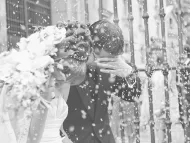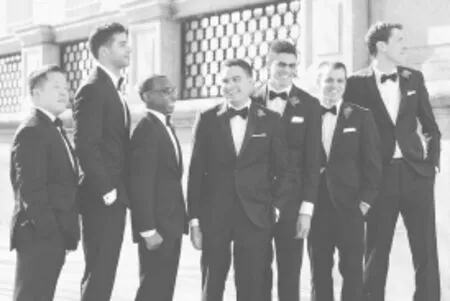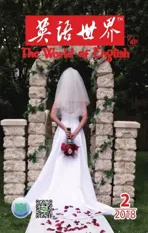16 Wedding Traditions and Their Origins16种婚礼传统及起源
2018-03-29
Have you ever been a flower girl,a bridesmaid, or caught the bouquet1bouquet 花束。at a friend’s wedding? All of these customs are expected at modern weddings, but these wedding traditions actually date back to2date back to 追溯到。ancient times.Since the origin of marriage about 23,000 years ago, different cultures have created their own wedding customs.Many of these customs have stood the test of time3stand the test of time 经得起时间的考验。and have evolved4evolve 逐步形成。into the wedding traditions we are familiar with today.
1. The Origin of Marriage
The origin of marriage dates back to 23,000 years ago when huntergatherers5hunter-gatherer 采猎者。became farmers, and gender roles around the household started to form. Males became responsible for gathering food, while females stayed at home to rear6rear 抚养。children. Thus, marriage soon became necessary as a way to ensure the survival of their offspring7offspring 后代。.
你当过女花童或伴娘吗?你在朋友的婚礼上接到过捧花吗?这些传统习俗是现代婚礼常见的,而其渊源其实可追溯到古代。婚姻起源于大约23000年前,此后,不同的文化创造了各自的婚礼风俗。其中许多风俗经受住时间的考验,逐渐发展成今日我们所熟悉的婚礼传统。

1.婚姻的起源
婚姻的起源可以追溯到大约23000年前,那时,采猎者已演化为农人,家庭中的性别角色开始形成。男性负责采集食物,女性留在家里抚养孩子。因此,婚姻很快变得不可或缺,以此确保后代能存活下去。
2. Wedding Veil
This wedding tradition dates back to the origin of arranged marriages.Traditionally, the groom’s family would not allow him to see his bride until the wedding. This is because if he didn’t like her looks, there was a chance that he might not agree to marry her.Therefore, the veil was used to conceal8conceal掩盖。the bride’s appearance up until the very moment in which they were to be married.
3. Cans Tied to the Bumper
The wedding tradition of tying cans to the bumper of the wedding car comes from the French custom of throwing a “charivari9charivari(在新婚者屋前敲铁锅、铜罐等的)逗闹音乐。” for the couple. The“charivari” was essentially a celebration that took place on a night before the wedding. Neighbors would walk down the streets and bang their pots and pans to make as much noise as possible throughout the village in order to scare away evil spirits. Since cans make noise when dragged behind a moving car,the classic “charivari” was adapted10adapt改装。to simply tying cans to the wedding car bumper.
4. Wedding Cake
Since cakes represent fertility11fertility 富饶。,Ancient Romans would bake wheat cakes and break them over the bride’s head. Soon it became customary to stack1212 stack 放成整齐的一叠。these wheat cakes one on top of another, as tall as they could go. The bride and groom were challenged to kiss over the tower without knocking it over. If successful, they’d enjoy a lifetime of good fortune as a couple.
2. 新娘的面纱
这种婚礼传统源于包办婚姻。以前,新郎家里不让他在婚礼前见到新娘。这么做是因为新郎若是不喜欢新娘的相貌,就有可能不同意娶她。因此,面纱用来盖住新娘的脸,直到两人成婚的那一刻。

3. 绑在保险杠上的罐头盒
把罐头盒绑在婚车的保险杠上这一婚礼传统来源于法国对新婚夫妇恶作剧的“吵闹游戏”。“吵闹游戏”其实是婚礼前夜的一种庆祝活动。邻居拿着锅碗瓢盆,沿街边走边敲打,在村子里动静闹得越大越好,这样才能吓走魔鬼。由于罐头盒绑在行驶的车辆上能发出噪音,传统的“吵闹游戏”就被简化成把罐头盒绑在婚车的保险杠上。
4. 结婚蛋糕
糕饼代表富饶,所以古罗马人烤完麦饼,并在新娘的头顶上方把饼弄碎。很快有了这样一个风俗,把麦饼一个叠着一个往上堆,堆得越高越好。新郎和新娘须接受挑战在堆叠的糕饼上方接吻,且不能打翻饼堆。如果成功,就能一辈子幸福美满。
5. Tie the Knot
During the Roman age, a common custom was to tie the bride and groom’s hands together during the ceremony. The couple could not be released until the marriage was official. This is a tradition that’s referred to as “handfasting”, and is a common practice amongst various cultures around the world.
6. Wedding Ring
The circle represents eternity,because it doesn’t have a beginning or an end. During ancient times, women would wear rings made of papyrus13papyrus 纸莎草。around their wrists and ankles. Romans then began to substitute the material with iron, which ultimately led to the use of gold to make the first betrothal14betrothal 订婚。rings. The tradition of a diamond engagement ring was started by Archduke15Archduke大公,欧洲贵族头衔。Maximilian of Austria when he proposed to Mary of Burgundy.Like circles, diamonds have long been considered as symbols of eternity because they are the hardest gems16gem 宝石。on earth. The placement of the ring on the fourth finger came from the Egyptians who believed that it was the finger that contained the vein17vein 静脉。that connects to the heart.
5. 打结
古罗马时期有个常见的风俗,婚礼上把新郎新娘的手绑在一起,直到正式成婚后才可解开此结。这一传统被称为“绑手礼”,在世界上多种文化中很常见。

6. 婚戒
圆圈代表永恒,因为它没有起点,亦无终点。古时,女子在手腕和脚踝上戴纸莎草做的环状饰品。后来古罗马人开始用铁做材料,最终人们用金子做出了第一枚订婚戒指。用钻戒订婚的传统始于奥地利大公马克西米利安,他用钻戒向勃艮第的玛丽求婚。像圆圈一样,钻石一直以来被视作永恒的象征,因为它是地球上最坚硬的宝石。在无名指上戴戒指的风俗出自埃及人,他们认为无名指上有连着心脏的血脉。
7. Flower Girl
The age-old wedding tradition of a flower girl stems from18stem from 起源于。an Ancient Roman tradition where young virgins would carry sheaths of wheat, which was believed to bring on well-being and good fortune to the newlyweds. Over time the sheaths of wheat have been replaced with flowers that are scattered along the path that leads up to the altar19altar 圣坛。.
8. Bridesmaids
In Ancient Rome, the purpose of having bridesmaids at a wedding was to protect the bride. The bridesmaids would each wear the same dress as the bride in order to confuse the evil spirits and prevent them from finding her. As a result, the couple would avoid being cursed on their wedding day.
9. Shower of Rice
Rice and other grains have long been regarded as signs of prosperity and fertility. Therefore, the practice of throwing rice at a wedding is symbolic of showering the couple with good fortune. Although it is an age-old wedding tradition, it is a practice that is becoming less popular, with rice being replaced by alternatives such as confetti20confetti(在婚礼或美国其他特殊活动中撒的)五彩纸屑。, bubbles, and sparklers.
7. 女花童
请女花童这一古老的婚礼传统源于古罗马。年幼的女童手捧几束小麦,人们相信这能给新人带来健康和好运。久而久之,小麦换成了花瓣,撒满了通往圣坛之路。
8. 伴娘
古罗马时期,请伴娘的目的是保护新娘。所有伴娘穿着跟新娘一样的衣服,这样可以迷惑恶魔,以防恶魔找到新娘。如此,新婚夫妇就能避免在婚礼当天受到诅咒。
9. 大米浴
长久以来,大米和其他谷物被视作繁荣与富饶的象征。因此,在婚礼上抛撒大米的做法象征着给新婚夫妇带去好运。虽说这是由来已久的婚礼传统,但这种做法越来越少见,大米也换成了五彩纸屑、气泡和冷烟花。
10. Something Blue
It is widely believed that the color white represents purity. However, it is actually the color blue that is the true symbol of purity as well as fidelity21fidelity 忠诚。.The symbolism of the color blue dates back to early Christianity, when the color was associated with the Virgin Mary, who is often depicted22depict 描绘。wearing a blue robe.
11. Honeymoon
The tradition of going on a honeymoon after a wedding, dates back to the 5th century when cultures represented the calendar time in moon cycles23moon cycle古时以月相的更替周期计算时间,一个月相周期约为29天。. Once married, a newlywed couple would drink mead, an alcoholic beverage made of honey, a tradition that would take place during their first moon24moon一轮月相更替。of marriage.
12. Bridal Bouquet
The first bridal bouquet was made out of aromatic bunches of herbs, garlic,and grains, which were ingredients that were believed to have the power of driving away evil spirits. Over time, the herb bouquet was gradually replaced by flowers which carry special meanings in different cultures around the world.

10. 蓝色之物
人们普遍认为白色代表纯洁。然而,事实上蓝色才真正象征忠诚与纯洁。蓝色的这一象征意义可以追溯到早期的基督教。那时人们说到蓝色,就会联想到圣母马利亚,她常常被描绘为身披蓝袍。
11.蜜月
婚后度蜜月的传统起源于公元5世纪,当时人们以月亮的盈亏周期表示日历时间。新婚夫妇成婚后要喝蜂蜜酒(用蜂蜜做的酒精饮料)。按照传统,婚后的第一个月(一轮月相更替)天天都要喝。
12. 新娘的捧花
最早的捧花是由带香味的香草、大蒜和谷物做成的。人们相信这些材料有驱逐恶魔的功效。随着时间的推移,世界不同的文化中,香草做的花束逐渐被具有特殊意义的鲜花所取代。
13. Groomsmen
The tradition of having groomsmen as part of the wedding, comes from the ancient tradition of kidnapping the bride. Before a couple could get married, a man had to employ his fellow friends or warrior companions to help him fight off other warriors and prevent the bride’s family from finding the couple. The groom’s main warrior companion would be the equivalent25equivalent 同等物。of the “best man” at a wedding.
14. Bouquet Toss
In 14th century Euro pe, it was common for wedding guests to rip off26rip off 撕下。sections of the bride’s dress for good luck. To prevent this, brides started throwing the garter instead. This led to guests, especially men, attempting to rip the garter off. Eventually it became tradition for the groom to remove and throw the garter and the bride to throw the bouquet.

13.伴郎
婚礼上请伴郎的传统源自绑架新娘的古老传统。新人成婚之前,男方必须请他的好哥们儿或战友帮他打退别的勇士,还不能让新娘的家里人找到他和新娘。新郎的主要战友就成了婚礼上的“伴郎”。
14.丢捧花
在14世纪的欧洲,参加婚礼的宾客常常撕下新娘婚纱上的一小块布来沾沾运气。为防止这种情况发生,新娘开始丢袜带。可这导致宾客——特别是男宾客——企图扯下袜带。最后就有了这样的传统:新郎脱下并丢出袜带,而新娘则丢捧花。
15. Ring Bearer
During Victorian times, a pageboy27pageboy新娘的伴童;小男傧相。was responsible for carrying a bride’s train down the aisle along with a prayer book. At the same time,Victorians began to place the ring on small pillows as a display of their wealth. This is because pillows used to be very expensive and were luxury items that only the elite28elite 社会精英。members of society could afford. Eventually, it became the pageboy’s responsibility to carry the ring pillow down the aisle and is a tradition that has evolved into the ring bearer that we are familiar with today.
16. Gift Registry
The origin of the wedding registry dates back to 1924 at a Marshall Field2919世纪末芝加哥首屈一指的百货店,后发展成在全美拥有700多家门店的大型百货公司。2006年被梅西百货公司(Macy’s)收购并更名。’s store in Chicago. Also known as a bridal registry, it was a way for the couple to choose their fine china and silver for their big day. Soon the idea spread across the country and was popularized30popularize 推广。in the retail industry to include wedding gifts for the couple. ■
15. 捧戒指的男伴童
维多利亚时代,新娘的男伴童负责托着新娘的裙裾步入殿堂,手里还得拿着一本祈祷书。同时,维多利亚时代的英国人把戒指放在小枕头上,用来展示他们的财富。因为枕头在以前非常昂贵,是只有社会的精英阶层才能用得起的奢侈品。最终,拿着戒枕走入殿堂成了男伴童的职责,进而演变成我们今日所熟悉的捧戒指的男伴童。
16. 礼物登记
结婚礼物登记最早出现于1924年芝加哥的一家马歇尔·菲尔德百货公司的门店。有人也称之为新娘的礼物登记单,新婚夫妇为大婚日子挑选的瓷器和银器都写在上面。这个主意很快传遍全美,在零售行业推广开来,便有了出售结婚礼物这门生意。 □
